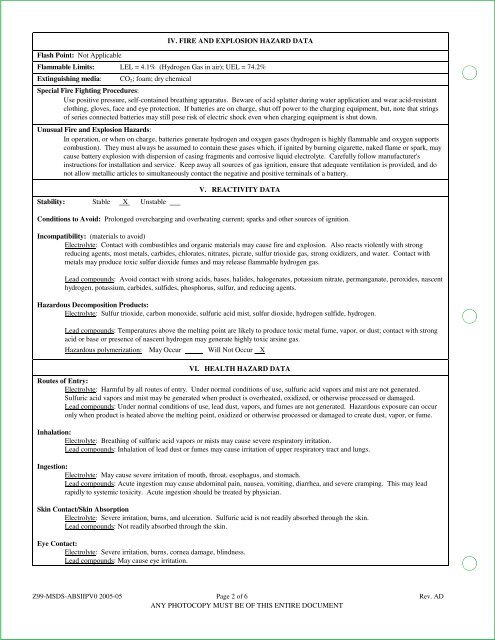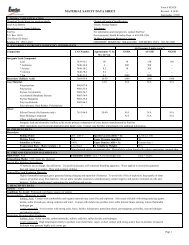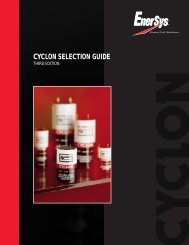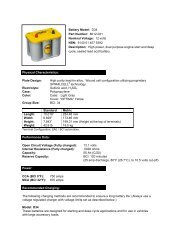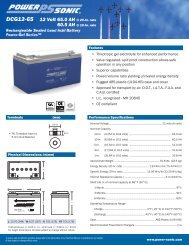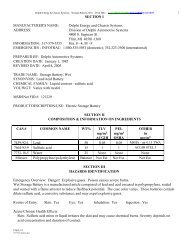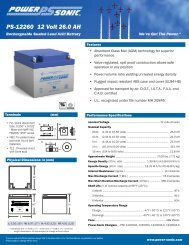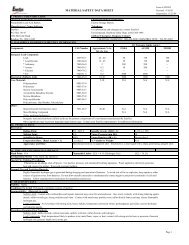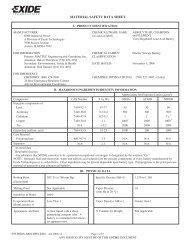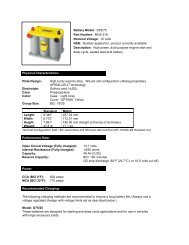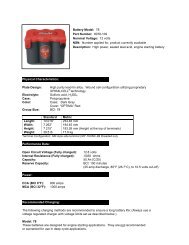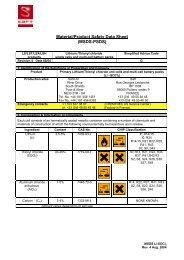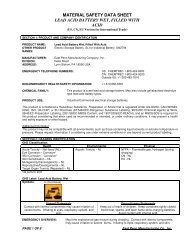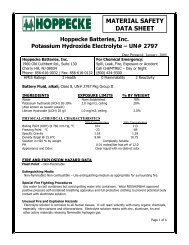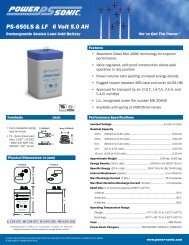Exide Absolyte IIP V0 MSDS - Battery Web
Exide Absolyte IIP V0 MSDS - Battery Web
Exide Absolyte IIP V0 MSDS - Battery Web
Create successful ePaper yourself
Turn your PDF publications into a flip-book with our unique Google optimized e-Paper software.
Flash Point: Not Applicable<br />
IV. FIRE AND EXPLOSION HAZARD DATA<br />
Flammable Limits: LEL = 4.1% (Hydrogen Gas in air); UEL = 74.2%<br />
Extinguishing media:<br />
CO 2 ; foam; dry chemical<br />
Special Fire Fighting Procedures:<br />
Use positive pressure, self-contained breathing apparatus. Beware of acid splatter during water application and wear acid-resistant<br />
clothing, gloves, face and eye protection. If batteries are on charge, shut off power to the charging equipment, but, note that strings<br />
of series connected batteries may still pose risk of electric shock even when charging equipment is shut down.<br />
Unusual Fire and Explosion Hazards:<br />
In operation, or when on charge, batteries generate hydrogen and oxygen gases (hydrogen is highly flammable and oxygen supports<br />
combustion). They must always be assumed to contain these gases which, if ignited by burning cigarette, naked flame or spark, may<br />
cause battery explosion with dispersion of casing fragments and corrosive liquid electrolyte. Carefully follow manufacturer's<br />
instructions for installation and service. Keep away all sources of gas ignition, ensure that adequate ventilation is provided, and do<br />
not allow metallic articles to simultaneously contact the negative and positive terminals of a battery.<br />
Stability: Stable X Unstable<br />
V. REACTIVITY DATA<br />
Conditions to Avoid: Prolonged overcharging and overheating current; sparks and other sources of ignition.<br />
Incompatibility: (materials to avoid)<br />
Electrolyte: Contact with combustibles and organic materials may cause fire and explosion. Also reacts violently with strong<br />
reducing agents, most metals, carbides, chlorates, nitrates, picrate, sulfur trioxide gas, strong oxidizers, and water. Contact with<br />
metals may produce toxic sulfur dioxide fumes and may release flammable hydrogen gas.<br />
Lead compounds: Avoid contact with strong acids, bases, halides, halogenates, potassium nitrate, permanganate, peroxides, nascent<br />
hydrogen, potassium, carbides, sulfides, phosphorus, sulfur, and reducing agents.<br />
Hazardous Decomposition Products:<br />
Electrolyte: Sulfur trioxide, carbon monoxide, sulfuric acid mist, sulfur dioxide, hydrogen sulfide, hydrogen.<br />
Lead compounds: Temperatures above the melting point are likely to produce toxic metal fume, vapor, or dust; contact with strong<br />
acid or base or presence of nascent hydrogen may generate highly toxic arsine gas.<br />
Hazardous polymerization: May Occur Will Not Occur X<br />
VI. HEALTH HAZARD DATA<br />
Routes of Entry:<br />
Electrolyte: Harmful by all routes of entry. Under normal conditions of use, sulfuric acid vapors and mist are not generated.<br />
Sulfuric acid vapors and mist may be generated when product is overheated, oxidized, or otherwise processed or damaged.<br />
Lead compounds: Under normal conditions of use, lead dust, vapors, and fumes are not generated. Hazardous exposure can occur<br />
only when product is heated above the melting point, oxidized or otherwise processed or damaged to create dust, vapor, or fume.<br />
Inhalation:<br />
Electrolyte: Breathing of sulfuric acid vapors or mists may cause severe respiratory irritation.<br />
Lead compounds: Inhalation of lead dust or fumes may cause irritation of upper respiratory tract and lungs.<br />
Ingestion:<br />
Electrolyte: May cause severe irritation of mouth, throat, esophagus, and stomach.<br />
Lead compounds: Acute ingestion may cause abdominal pain, nausea, vomiting, diarrhea, and severe cramping. This may lead<br />
rapidly to systemic toxicity. Acute ingestion should be treated by physician.<br />
Skin Contact/Skin Absorption<br />
Electrolyte: Severe irritation, burns, and ulceration. Sulfuric acid is not readily absorbed through the skin.<br />
Lead compounds: Not readily absorbed through the skin.<br />
Eye Contact:<br />
Electrolyte: Severe irritation, burns, cornea damage, blindness.<br />
Lead compounds: May cause eye irritation.<br />
Z99-<strong>MSDS</strong>-ABS<strong>IIP</strong><strong>V0</strong> 2005-05 Page 2 of 6 Rev. AD<br />
ANY PHOTOCOPY MUST BE OF THIS ENTIRE DOCUMENT


